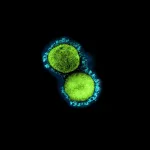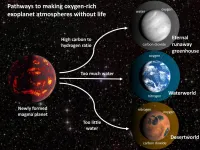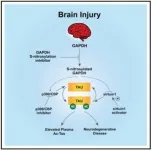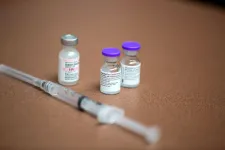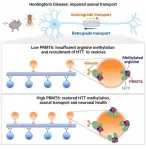(Press-News.org) A study done in rooms where COVID-19 patients were isolated shows that the virus's RNA - part of the genetic material inside a virus - can persist up to a month in dust.
The study did not evaluate whether dust can transmit the virus to humans. It could, however, offer another option for monitoring COVID-19 outbreaks in specific buildings, including nursing homes, offices or schools.
Karen Dannemiller, senior author of the study, has experience studying dust and its relationship to potential hazards like mold and microbes.
"When the pandemic started, we really wanted to find a way that we could help contribute knowledge that might help mitigate this crisis," said Dannemiller, assistant professor of civil, environmental and geodetic engineering and environmental health sciences at The Ohio State University.
"And we've spent so much time studying dust and flooring that we knew how to test it."
The study, published today (April 13, 2021) in the journal mSystems, found some of the genetic material at the heart of the virus persists in dust, even though it is likely that the envelope around the virus may break down over time in dust. The envelope - the crown-like spiked sphere that contains the virus's material - plays an important role in the virus's transmission to humans.
The study offers another non-invasive avenue for monitoring buildings for COVID-19 outbreaks, especially as more people are vaccinated and return to communal spaces.
Municipalities and others have tested wastewater to evaluate the prevalence of COVID-19 in a given community - gene copies and fragments of the virus live in human waste, and by testing wastewater, local governments and others can determine how widespread the virus might be, even if people are asymptomatic.
Dust monitoring could offer similar understanding on a smaller scale - say, a specific nursing home, hospital or school.
"In nursing homes, for example, you're still going to need to know how COVID is spreading inside the building," said Nicole Renninger, lead author of the paper and an engineering graduate student in Dannemiller's lab. "For surveillance purposes, you need to know if you are picking up an outbreak that's going on right now."
For this study, the research team worked with the crews responsible for cleaning the rooms at Ohio State where students who tested positive for COVID-19 were isolated. They also collected samples from two homes where people who tested positive for COVID-19 lived. They gathered vacuum bags of dust from the cleaning crews and from the homes.
The researchers also tested swabs collected from surfaces in the rooms.
They found genetic material from the SARS-CoV-2 virus - the virus that causes COVID-19 - in 97% of the bulk dust samples and in 55% of the surface swabs.
The cleaning crews sprayed a chlorine-based disinfectant in the rooms prior to cleaning; the researchers believe that disinfectant destroyed the envelope and/or capsid - the outer coat surrounding the virus - likely defanging it for transmission.
The research team tested the samples when they arrived at the lab, shortly after the rooms were cleaned, then tested the samples again weekly. After four weeks, the virus's RNA did not significantly decay in the vacuum bags.
"We weren't sure that the genetic material would survive - there are many different organisms in dust, and we weren't sure we'd see any viral RNA at all," Renninger said. "And we were surprised when we found that the actual RNA itself seems to be lasting a pretty long time."
Testing dust to monitor for COVID-19 outbreaks would likely be most useful for smaller-scale communities with a high-risk population - a nursing home, for example, Dannemiller said. Testing indoor dust is also likely less expensive at that scale than testing wastewater or all individuals directly on a routine basis.
"We wanted to demonstrate that dust could be complementary to wastewater for surveillance," Dannemiller said. "Wastewater is great for a large population, but not everybody sheds the virus in feces, and you have to collect wastewater samples, which not everyone wants to do. People are already vacuuming these rooms, so dust may be a good option for some groups."
Even before this study was published, Dannemiller said the researchers presented their findings to an industry group that represents maintenance and cleaning staff, with a recommendation: "If they can wait at least an hour or more after a person leaves the room to clean, they should," she said, citing previous studies of viral viability on other materials and in aerosols.
INFORMATION:
Other Ohio State researchers who worked on this study include Nick Nastasi, Ashleigh Bope, Samuel Cochran, Sarah Haines, Neeraja Balasubrahmaniam, Katelyn Stuart and Natalie Hull. Kyle Bibby, an associate professor of engineering at the University of Notre Dame, and Aaron Bivins, a postdoc in his group, also contributed.
WHAT:
Many people who have COVID-19 make a full recovery and return to their baseline state of health; however, some people have symptoms or other sequelae weeks or months after initial SARS-CoV-2 infection. These heterogeneous symptoms were the subject of the virtual "Workshop on Post-acute Sequelae of COVID-19" hosted on Dec. 2 and 4, 2020, by the National Institute of Allergy and Infectious Diseases (NIAID), in collaboration with other institutes and centers of the National Institutes of Health. A paper published recently in Annals of Internal Medicine ...
Researchers have identified molecular signatures of the aging process in mice, publishing their results today in the open-access eLife journal.
Their analyses provide one of the most comprehensive characterisations of the molecular signatures of aging across diverse types of cells from different tissues in a mammal, and will aid future studies on aging and related topics.
Aging leads to the decline of major organs and is the main risk factor for many diseases, including cancer, cardiovascular and neurodegenerative diseases. While previous studies have highlighted different hallmarks of the aging process, the underlying molecular and cellular mechanisms ...
In the search for life on other planets, the presence of oxygen in a planet's atmosphere is one potential sign of biological activity that might be detected by future telescopes. A new study, however, describes several scenarios in which a lifeless rocky planet around a sun-like star could evolve to have oxygen in its atmosphere.
The new findings, published April 13 in AGU Advances, highlight the need for next-generation telescopes that are capable of characterizing planetary environments and searching for multiple lines of evidence for life in addition to detecting oxygen.
"This ...
After interviewing various stakeholders from public and private healthcare systems (in Lithuania and the US), researchers Dr Agne Gadeikiene, Prof Asta Pundziene, Dr Aiste Dovaliene from Kaunas University of Technology (KTU), Lithuania designed a detailed structure revealing added value of remote healthcare services, i.e. telehealth. Adopting the concept of value co-creation common in business research to healthcare, the scientists claim that this is the first comprehensive analysis of this kind in the healthcare field involving two different healthcare systems.
According to the researchers, although in the US the consultations via phone with physician have been available for more than fifty ...
A gene therapy protects eye cells in mice with a rare disorder that causes vision loss, especially when used in combination with other gene therapies, shows a study published today in eLife.
The findings suggest that this therapy, whether used alone or in combination with other gene therapies that boost eye health, may offer a new approach to preserving vision in people with retinitis pigmentosa or other conditions that cause vision loss.
Retinitis pigmentosa is a slowly progressive disease, which begins with the loss of night vision due to ...
Violent blows or jolts to the head can cause traumatic brain injury (TBI), and there are currently about five million people in the U.S. living with some form of chronic impairment after suffering a TBI. Even in a mild form, TBI can lead to lifelong nerve cell deterioration associated with a wide array of neuropsychiatric conditions. Tragically, there are no medicines to protect nerve cells after injury. Behind aging and genetics, TBI is the third leading cause of Alzheimer's disease (AD), yet the link between these two conditions is not understood.
In a new study, published online today in Cell, researchers have discovered a new way to prevent brain nerve cells from deteriorating after injury, which also revealed a potential mechanistic ...
AMES, Iowa - Narratives are a powerful tool that can help explain complex issues, but they can also serve as sources of misinformation, which presents a challenge as public health agencies work to educate people about COVID-19 vaccine.
In a paper published by the Proceedings of the National Academy of Sciences, author Michael Dahlstrom, a professor and director of Iowa State University's Greenlee School of Journalism and Mass Communication, examined how narratives or storytelling can help counter misinformation and provide a connection between science and the human experience. Dahlstrom says simply presenting the facts, without some connection, may not help people make ...
Bottom Line: The U.S. Preventive Services Task Force (USPSTF) concludes that the current evidence is insufficient to make a recommendation about screening for vitamin D deficiency in asymptomatic adults. Vitamin D performs an important role in bone metabolism. Requirements may vary by individual and no one blood vitamin D level defines deficiency. The USPSTF routinely makes recommendations about the effectiveness of preventive care services and this recommendation updates and is consistent with its 2014 statement.
To access the embargoed study: Visit our For The Media website at this link https://media.jamanetwork.com/
(doi:10.1001/jama.2021.3069)
Editor's Note: Please see the article for additional ...
New research led by the Garvan Institute of Medical Research has revealed how breast cancer cells that develop during or after pregnancy change their environment to form more aggressive tumours.
In experimental models of pregnancy-associated breast cancer, researchers found that cancer cells send signals to the connective tissue around them to trigger uncontrolled inflammation and remodel the tissue, which in turn helps the cancer to spread.
"Breast cancers that arise during or shortly after pregnancy are highly aggressive as they often become resistant to standard therapies. With 50% of cases ...
Huntington's disease is a genetic neurodegenerative disorder caused by mutations in the protein huntingtin and characterized by involuntary dance-like movements, severe behavioural changes and cognitive impairment. That neuronal traffic is impaired in this disease has been very well known for several years. But that this deranged trafficking could be ameliorated by increasing huntingtin methylation was not yet known. The findings emerged from an international research work coordinated by the University of Trento and published in Cell Reports.
The research teams identified the fundamental role of the protein arginine methyltransferase PRMT6 in ensuring transport along axons, the routes that connect nerve cells to each other, and hence the health of neurons. ...
